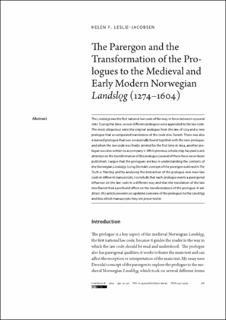The Parergon and the Transformation of the Prologues to the Medieval and Early Modern Norwegian 'Landslǫg' (1274–1604)
Journal article, Peer reviewed
Published version

Åpne
Permanent lenke
https://hdl.handle.net/11250/3062255Utgivelsesdato
2022Metadata
Vis full innførselSamlinger
Originalversjon
Interfaces: A Journal of Medieval European Literatures. 2022, 9, 10-39. 10.54103/interfaces-09-03Sammendrag
The Landslǫg was the first national law code of Norway, in force between 1274 and 1687. During this time, several different prologues were appended to the law code. The most ubiquitous were the original prologue from the law of 1274 and a new prologue that accompanied translations of the code into Danish. There was also a learned prologue that was occasionally found together with the new prologue, and when the law code was finally printed for the first time in 1604, another prologue was also written to accompany it. While previous scholarship has paid scant attention to the transformation of the prologue (several of them have never been published), I argue that the prologues are key in understanding the contexts of the Norwegian Landslǫg. Using Derrida's concept of the parergon outlined in The Truth in Painting and by analysing the interaction of the prologue and main law code in different manuscripts, I conclude that each prologue exerts a parergonal influence on the law code in a different way and that the translation of the law into Danish had a profound effect on the transformations of the prologue. In addition, this article provides an updated overview of the prologues to the Landslǫg and lists which manuscripts they are preserved in.
